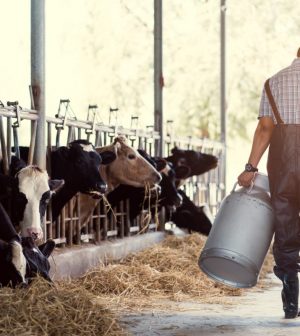- Navigating Your Midlife Crisis: Embracing New Possibilities
- City Raccoons Showing Signs of Domestication
- Mapping the Exposome: Science Broadens Focus to Environmental Disease Triggers
- One Week Less on Social Media Linked to Better Mental Health
- Your Brain Changes in Stages as You Age, Study Finds
- Some Suicide Victims Show No Typical Warning Signs, Study Finds
- ByHeart Formula Faces Lawsuits After Babies Sickened With Botulism
- Switch to Vegan Diet Could Cut Your Greenhouse Gas Emissions in Half
- Regular Bedtime Does Wonders for Blood Pressure
- Dining Alone Could Mean Worse Nutrition for Seniors
California Declares Bird Flu Emergency as Outbreak in Cows Continues

California Gov. Gavin Newsom declared a public health emergency on Wednesday as bird flu continues to spread among the state’s dairy cattle.
“This proclamation is a targeted action to ensure government agencies have the resources and flexibility they need to respond quickly to this outbreak,” Newsom explained in a news release announcing the move. “While the risk to the public remains low, we will continue to take all necessary steps to prevent the spread of this virus.”
The move comes on the heels of a Louisiana resident being hospitalized with bird flu (H5N1), the first severe case confirmed in the United States.
The country’s bird flu outbreak, which began in Texas earlier this year, has now spread to 16 states, with 865 infected herds identified as of Wednesday.
California has been hit particularly hard, with 645 affected dairies, about half of which were reported in just the past 30 days.
While experts maintain that the virus cannot yet spread easily among people, each infection in animals increases the risk of the virus mutating into a form more transmissible between humans.
The U.S. Centers for Disease Control and Prevention has confirmed 61 human cases of H5N1 infection nationwide, with another seven cases deemed “probable.”
Over half of the confirmed cases — 32 — are in California. While 37 of these infections have been traced to interactions with infected cattle, others are linked to diseased birds or other animals and several cases remain of unknown origin.
“All these infections in so many species around us is paving a bigger and bigger runway for the virus to potentially evolve to infect humans better and transmit between humans,” Dr. Nahid Bhadelia, director of the Boston University Center on Emerging Infectious Diseases, told the New York Times.
Bird flu has been spreading in poultry since 2022, and cases in dairy cows began to crop up last March. The virus was discovered in a pig for the first time recently.
Earlier this month, Canadian officials announced that a teen in British Columbia had been hospitalized in critical condition with what is believed to be bird flu.
It’s not clear how the teenager picked up the H5N1 virus because the patient is not known to have any contact with infected animals, officials noted. They added that this is the first human case of the virus reported in both the province and Canada.
“The positive test for H5 was performed at the BC Centre for Disease Control’s Public-Health Laboratory,” Dr. Bonnie Henry, provincial health officer of British Columbia, said in a statement.
Testing has been performed on about three dozen people who were in contact with the teen, but none show evidence of infection, Henry added.
“We should be very concerned at this point,” Dr. James Lawler, co-director of the University of Nebraska’s Global Center for Health Security, told the Times. “Nobody should be hitting the panic button yet, but we should really be devoting a lot of resources into figuring out what’s going on.”
More information
The CDC has more on bird flu.
SOURCES: Gov. Gavin Newsom’s office, news release, Dec. 18, 2024; U.S. Centers for Disease Control and Prevention, health update, Dec. 18, 2024; British Columbia Ministry of Health, news release, Nov. 9, 2024; New York Times
Source: HealthDay
Copyright © 2025 HealthDay. All rights reserved.










